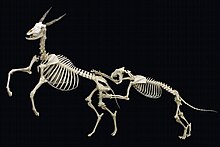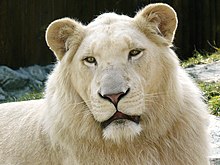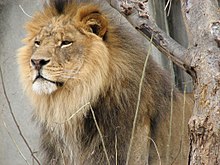lion the strong
The lion (Panthera leo ) is one of the four big cats in the genusPanthera and a member of the family Felidae . With some males exceeding 250 kg (550 lb) in weight,[ 4] it is the second-largest living cat after the tiger . Wild lions currently exist in sub-Saharan Africa and in Asia (with an endangered remnant populations reside in Gir Forest National Park in India ) while other types of lions have disappeared from North Africa and Southwest Asia in historic times. Until the late Pleistocene , about 10,000 years ago, the lion was the most widespread large land mammal after humans. They were found in most of Africa, across Eurasia from western Europe to India, and in the Americas from the Yukon to Peru .[ 5] The lion is a vulnerable species , having seen a major population decline of 30–50% over the past two decades[date missing ] in its African range.[ 2] Lion populations are untenable outside designated reserves and national parks. Although the cause of the decline is not fully understood, habitat loss and conflicts with humans are currently the greatest causes of concern. Within Africa, the West African lion population is particularly endangered.
Lions live for 10–14 years in the wild, while in captivity they can live longer than 20 years. In the wild, males seldom live longer than 10 years, as injuries sustained from continual fighting with rival males greatly reduce their longevity.[ 6] They typically inhabit savanna and grassland , although they may take to bush and forest . Lions are unusually social compared to other cats. A pride of lions consists of related females and offspring and a small number of adult males. Groups of female lions typically hunt together, preying mostly on large ungulates . Lions are apex and keystone predators , although they scavenge as opportunity allows. While lions do not typically hunt humans, some have been known to do so. Sleeping mainly during the day, lions are primarily nocturnal , although bordering on crepuscular[ 7][ 8] in nature.
Highly distinctive, the male lion is easily recognised by its mane, and its face is one of the most widely recognised animal symbols in human culture . Depictions have existed from the Upper Paleolithic period, with carvings and paintings from the Lascaux and Chauvet Caves , through virtually all ancient and medieval cultures where they once occurred. It has been extensively depicted in sculptures, in paintings, on national flags, and in contemporary films and literature. Lions have been kept in menageries since the time of the Roman Empire , and have been a key species sought for exhibition in zoos over the world since the late 18th century. Zoos are cooperating worldwide in breeding programs for the endangered Asiatic subspecies .
Contents |
Etymology
The lion's name, similar in many Romance languages , is derived from the Latinleo ;[ 9] and the Ancient Greekλ?ων (leon ).[ 10] The Hebrew word ?????? (lavi ) may also be related.[ 11] It was one of the many species originally described by Linnaeus , who gave it the name Felis leo , in his 18th-century work, Systema Naturae .[ 3]
Taxonomy and evolution
The lion's closest relatives are the other species of the genus Panthera : the tiger , the jaguar , and the leopard . P. leo evolved in Africa between 1 million and 800,000 years ago, before spreading throughout the Holarctic region.[ 12] It appeared in the fossil record in Europe for the first time 700,000 years ago with the subspecies Panthera leo fossilis at Isernia in Italy . From this lion derived the later cave lion (Panthera leo spelaea ), which appeared about 300,000 years ago.[ 13] Lions died out in northern Eurasia at the end of the last glaciation , about 10,000 years ago;[ 14] this may have been secondary to the extinction of Pleistocene megafauna .[ 15]
Subspecies
Traditionally, 12 recent subspecies of lion were recognised, distinguished by mane appearance, size, and distribution. Because these characteristics are very insignificant and show a high individual variability, most of these forms were probably not true subspecies, especially as they were often based upon zoo material of unknown origin that may have had "striking, but abnormal" morphological characteristics.[ 16] Today, only eight subspecies are usually accepted,[ 14][ 17] although one of these, the Cape lion , formerly described as Panthera leo melanochaita , is probably invalid.[ 17] Even the remaining seven subspecies might be too many. While the status of the Asiatic lion (P. l. persica ) as a subspecies is generally accepted, the systematic relationships among African lions are still not completely resolved. Mitochondrial variation in living African lions seemed to be modest according to some newer studies, therefore all sub-Saharan lions sometimes have been considered a single subspecies. However, a recent study revealed lions from western and central Africa differ genetically from lions of southern or eastern Africa. According to this study, Western African lions are more closely related to Asian lions than to South or East African lions. These findings might be explained by a late Pleistocene extinction event of lions in western and central Africa and a subsequent recolonisation of these parts from Asia.[ 18] Previous studies, which were focused mainly on lions from eastern and southern parts of Africa, already showed these can be possibly divided in two main clades : one to the west of the Great Rift Valley and the other to the east. Lions from Tsavo in eastern Kenya are much closer genetically to lions in Transvaal (South Africa), than to those in the Aberdare Range in western Kenya.[ 19] Another study revealed there are three major types of lions, one North African–Asian, one southern African and one middle African.[ 20] Conversely, Per Christiansen found that using skull morphology allowed him to identify the subspecies krugeri , nubica , persica , and senegalensis , while there was overlap between bleyenberghi with senegalensis and krugeri . The Asiatic lion persica was the most distinctive, and the Cape lion had characteristics allying it more with P. l. persica than the other sub-Saharan lions. He had analysed 58 lion skulls in three European museums.[ 21]
By far most lions, which are kept in zoos are hybrids of different subspecies. About 77% of the captive lions registered by the International Species Information System are of unknown origin. Nonetheless, they might carry genes, which are extinct in the wild and might be therefore important to maintain overall genetic variability of the lion.[ 22] It is believed, that those lions, which were imported to Europe until the middle of the 19th century, were mainly Barbary lions from North Africa or lions from the Cape.[ 23]
Recent
Eight recent (Holocene ) subspecies are recognised today:
- P. l. persica , known as the Asiatic Lion or South Asian, Persian, or Indian lion, once was widespread from Turkey , across Southwest Asia , to Pakistan , India , and even to Bangladesh . However, large prides and daylight activity made them easier to poach than tigers or leopards;[ 24] now around 400 exist in and near the Gir Forest of India.[ 25] Genetic evidence suggests its ancestors split from the ancestors of sub-Saharan African lions between 203 and 74 thousand years ago.[ 14]
- P. l. leo , known as the Barbary lion , originally ranged from Morocco to Egypt . It is extinct in the wild due to excessive hunting, as the last wild Barbary lion was killed in Morocco in 1922.[ 26] This was one of the largest of the lion subspecies,[ 27] with reported lengths of 3.0–3.3 m (9.8–10.8 ft) and weights of more than 200 kg (440 lb) for males. It appears to be more closely related to the Asiatic rather than sub-Saharan lions. A number of animals in captivity are likely to be Barbary lions,[ 28] particularly the 90 animals descended from the Moroccan Royal collection at Rabat Zoo.[ 29]
- P. l. senegalensis , known as the West African lion , is found in western Africa , from Senegal to the Central African Republic .[ 30][ 31]
- P. l. azandica , known as the northeast Congo Lion, is found in the northeastern parts of the Congo .[ 30]
- P. l. nubica , known as the East African or Masai lion is found in East Africa, from Ethiopia and Kenya to Tanzania and Mozambique ;[ 31] a local population is known as the Tsavo lion .
- P. l. bleyenberghi , known as the southwest African or Katanga lion , is found in southwestern Africa, Namibia , Botswana , Angola , Katanga (Democratic Republic of the Congo ), Zambia , and Zimbabwe .[ 31]
- P. l. krugeri , known as the southeast African or Transvaal lion , is found in the Transvaal region of southeastern Africa, including Kruger National Park .[ 31]
- P. l. melanochaita , known as the Cape lion , became extinct in the wild around 1860. Results of mitochondrial DNA research do not support its status as a distinct subspecies. The Cape lion probably was only the southernmost population of the extant P. l. krugeri .[ 17]
- The potential of a newly discovered/discerned lion species could exist in captivity in Ethiopia's capital city of Addis Ababa - a late November 2012 Internet news item mentions fifteen lions in captivity being tested for their DNA genomes, to try defining if they are a new subspecies with the males having an unusually dark and luxuriant mane, or perhaps a mutation of either of the existing azandica or nubica subspecies known to be native to Ethiopia.[ 32]
Pleistocene
Several additional subspecies of lion existed in prehistoric times:
- P. l. fossilis , known as the Middle Pleistocene European cave lion, flourished about 500,000 years ago; fossils have been recovered from Germany and Italy . It was larger than today's African lions, reaching sizes comparable to the American cave lion and slightly larger than the Upper Pleistocene European cave lion.[ 14][ 33]
.jpg/220px-Lions_painting,_Chauvet_Cave_(museum_replica).jpg)
- P. l. spelaea , known as the European cave lion, Eurasian cave lion, or Upper Pleistocene European cave lion, occurred in Eurasia 300,000 to 10,000 years ago.[ 14] This species is known from Paleolithiccave paintings , ivory carvings, and clay busts,[ 34] indicating it had protruding ears, tufted tails, perhaps faint tiger-like stripes, and at least some males had a ruff or primitive mane around their necks.[ 35]
- P. l. atrox , known as the American lion or American cave lion, was abundant in the Americas from Canada to Peru in the Pleistocene Epoch until about 10,000 years ago. This form is the sister clade of P. l. spelaea , and likely arose when an early P. l. spelaea population became isolated south of the North American continental ice sheet about 0.34 Mya.[ 36] One of the largest purported lion subspecies to have existed, its body length is estimated to have been 1.6–2.5 m (5–8 ft).[ 37]
Dubious
- P. l. youngi or Panthera youngi , flourished 350,000 years ago.[ 5] Its relationship to the extant lion subspecies is obscure, and it probably represents a distinct species.
- P. l. sinhaleyus , known as the Sri Lanka lion , appears to have become extinct around 39,000 years ago. It is only known from two teeth found in deposits at Kuruwita . Based on these teeth, P. Deraniyagala erected this subspecies in 1939.[ 38]
- P. l. vereshchagini , the Beringian cave lion of Yakutia (Russia ), Alaska (USA ), and the Yukon Territory (Canada ), has been considered a subspecies separate from P. l. spelaea on morphological grounds. However, mitochondrial DNA sequences obtained from cave lion fossils from Europe and Alaska were indistinguishable.[ 36]
- P. l. europaea , known as the European lion , was probably identical with Panthera leo persica or Panthera leo spelea ; its status as a subspecies is unconfirmed. It became extinct around 100 AD due to persecution and over-exploitation . It inhabited the Balkans , the Italian Peninsula , southern France , and the Iberian Peninsula . It was a very popular object of hunting among ancient Romans and Greeks .
- P. l. maculatus , known as the marozi or spotted lion, sometimes is believed to be a distinct subspecies, but may be an adult lion that has retained its juvenile spotted pattern. If it was a subspecies in its own right, rather than a small number of aberrantly coloured individuals, it has been extinct since 1931. A less likely identity is a natural leopard-lion hybrid commonly known as a leopon .[ 39]
Hybrids
Lions have been known to breed with tigers (most often the Siberian and Bengal subspecies) to create hybrids called ligers and tiglons (or tigons).[ 40] They also have been crossed with leopards to produce leopons ,[ 41] and jaguars to produce jaglions . The marozi is reputedly a spotted lion or a naturally occurring leopon, while the Congolese spotted lion is a complex lion-jaguar-leopard hybrid called a lijagulep. Such hybrids were once commonly bred in zoos, but this is now discouraged due to the emphasis on conserving species and subspecies. Hybrids are still bred in private menageries and in zoos in China .
The liger is a cross between a male lion and a tigress.[ 42] Because the growth-inhibiting gene from the female tiger is absent, a growth-promoting gene is passed on by the male lion, the resulting ligers grow far larger than either parent. They share physical and behavioural qualities of both parent species (spots and stripes on a sandy background). Male ligers are sterile, but female ligers are often fertile. Males have about a 50% chance of having a mane, but if they grow them, their manes will be modest: around 50% the size of a pure lion mane. Ligers are typically 3.0 to 3.7 m (10 to 12 feet) in length, and can weigh 360 to 450 kg (800 to 1,000 pounds).[ 42] The less common tiglon or tigon is a cross between a lioness and a male tiger.[ 43] In contrast to ligers, tigons are often relatively small in comparison to their parents, because of reciprocal gene effects.[ 44]
Characteristics

The lion is the tallest (at the shoulder) of all living cats, averaging about 14 cm (5.5 in) taller than the tiger . Behind only the tiger, the lion is the second largest living felid in length and weight. Its skull is very similar to that of the tiger, although the frontal region is usually more depressed and flattened, with a slightly shorter postorbital region. The lion's skull has broader nasal openings than the tiger. However, due to the amount of skull variation in the two species, usually, only the structure of the lower jaw can be used as a reliable indicator of species.[ 45] Lion coloration varies from light buff to yellowish, reddish, or dark ochraceous brown. The underparts are generally lighter and the tail tuft is black. Lion cubs are born with brown rosettes (spots) on their body, rather like those of a leopard. Although these fade as lions reach adulthood, faint spots often may still be seen on the legs and underparts, particularly on lionesses.
Lions are the only members of the cat family to display obvious sexual dimorphism – that is, males and females look distinctly different. They also have specialised roles that each gender plays in the pride. For instance, the lioness, the hunter, lacks the male's thick mane. The colour of the male's mane varies from blond to black, generally becoming darker as the lion grows older.
Weights for adult lions range between 150–250 kg (330–550 lb) for males and 120–182 kg (264–400 lb) for females.[ 4] Nowell and Jackson report average weights of 181 kg (400 lb) for males and 126 kg (280 lb) for females.[ 26] Lions tend to vary in size depending on their environment and area, resulting in a wide spread in recorded weights. For instance, lions in southern Africa tend to be about 5 percent heavier than those in East Africa , in general.[ 46]
Head and body length is 170–250 cm (5 ft 7 in – 8 ft 2 in) in males and 140–175 cm (4 ft 7 in – 5 ft 9 in) in females; shoulder height is up to 123 cm (4 ft) in males and as low as 91 cm (3 ft) in females.[ 47] The tail length is 90–105 cm (2 ft 11 in - 3 ft 5 in) in males and 70–100 cm in females (2 ft 4 in – 3 ft 3 in).[ 4] The longest known lion, at nearly 3.6 m (12 ft) in total length, was a black-maned male shot near Mucsso, southern Angola in October 1973; the heaviest lion known in the wild was a man-eater shot in 1936 just outside Hectorspruit in eastern Transvaal , South Africa and weighed 313 kg (690 lb).[ 48] Another notably outsized male lion, which was shot near Mount Kenya , weighed in at 272 kg (600 lb).[ 26] Lions in captivity tend to be larger than lions in the wild – the heaviest lion on record is a male at Colchester Zoo in England named Simba in 1970, which weighed 375 kg (826 lb).[ 49] However, the frequently cited maximum head and body length of 250 cm (8 ft 2 in) fits rather to extinct Pleistocene forms, like the American lion , with even large modern lions measuring several centimeters less in length.[ 50]
The most distinctive characteristic shared by both females and males is that the tail ends in a hairy tuft. In some lions, the tuft conceals a hard "spine" or "spur", approximately 5 mm long, formed of the final sections of tail bone fused together. The lion is the only felid to have a tufted tail – the function of the tuft and spine are unknown. Absent at birth, the tuft develops around 5½ months of age and is readily identifiable at 7 months.[ 51]
Mane
The mane of the adult male lion, unique among cats, is one of the most distinctive characteristics of the species. It makes the lion appear larger, providing an excellent intimidation display; this aids the lion during confrontations with other lions and with the species' chief competitor in Africa, the spotted hyena .[ 52] The presence, absence, colour, and size of the mane is associated with genetic precondition, sexual maturity, climate, and testosterone production; the rule of thumb is the darker and fuller the mane, the healthier the lion. Sexual selection of mates by lionesses favors males with the densest, darkest mane.[ 53] Research in Tanzania also suggests mane length signals fighting success in male–male relationships. Darker-maned individuals may have longer reproductive lives and higher offspring survival, although they suffer in the hottest months of the year.[ 54] In prides including a coalition of two or three males, it is possible that lionesses solicit mating more actively with the males who are more heavily maned.[ 53]

Scientists once believed that the distinct status of some subspecies could be justified by morphology , including the size of the mane. Morphology was used to identify subspecies such as the Barbary lion and Cape lion . Research has suggested, however, that environmental factors influence the colour and size of a lion's mane, such as the ambient temperature .[ 54] The cooler ambient temperature in European and North American zoos , for example, may result in a heavier mane. Thus the mane is not an appropriate marker for identifying subspecies.[ 17][ 55] The males of the Asiatic subspecies, however, are characterised by sparser manes than average African lions.[ 56]
In the Pendjari National Park area almost all males are maneless or have very weak manes.[ 57] Maneless male lions have also been reported from Senegal and from Tsavo East National Park in Kenya, and the original male white lion from Timbavati also was maneless. The testosterone hormone has been linked to mane growth, therefore castrated lions often have minimal to no mane, as the removal of the gonads inhibits testosterone production.[ 58]
Cave paintings of extinct European cave lions exclusively show animals with no mane, or just the hint of a mane, suggesting that they were maneless.[ 35]
White lions

The white lion is not a distinct subspecies, but a special morph with a genetic condition, leucism ,[ 16] that causes paler colouration akin to that of the white tiger ; the condition is similar to melanism , which causes black panthers . They are not albinos, having normal pigmentation in the eyes and skin. White Transvaal lion (Panthera leo krugeri) individuals occasionally have been encountered in and around Kruger National Park and the adjacent Timbavati Private Game Reserve in eastern South Africa, but are more commonly found in captivity , where breeders deliberately select them. The unusual cream colour of their coats is due to a recessive gene .[ 59] Reportedly, they have been bred in camps in South Africa for use as trophies to be killed during canned hunts .[ 60]
Behaviour
Lions spend much of their time resting and are inactive for about 20 hours per day.[ 61] Although lions can be active at any time, their activity generally peaks after dusk with a period of socializing, grooming, and defecating. Intermittent bursts of activity follow through the night hours until dawn, when hunting most often takes place. They spend an average of two hours a day walking and 50 minutes eating.[ 62]
Group organization
Lions are the most socially inclined of all wild felids , most of which remain quite solitary in nature. The lion is a predatory carnivore who manifest two types of social organization. Some are residents, living in groups, called prides .[ 63] The pride usually consists of five or six related females, their cubs of both sexes, and one or two males (known as a coalition if more than one) who mate with the adult females (although extremely large prides, consisting of up to 30 individuals, have been observed). The number of adult males in a coalition is usually two, but may increase to four and decrease again over time. Male cubs are excluded from their maternal pride when they reach maturity.
The second organizational behaviour is labeled nomads , who range widely and move about sporadically, either singularly or in pairs.[ 63] Pairs are more frequent among related males who have been excluded from their birth pride. Note that a lion may switch lifestyles; nomads may become residents and vice versa. Males have to go through this lifestyle and some never are able to join another pride. A female who becomes a nomad has much greater difficulty joining a new pride, as the females in a pride are related, and they reject most attempts by an unrelated female to join their family group.
The area a pride occupies is called a pride area , whereas that by a nomad is a range .







